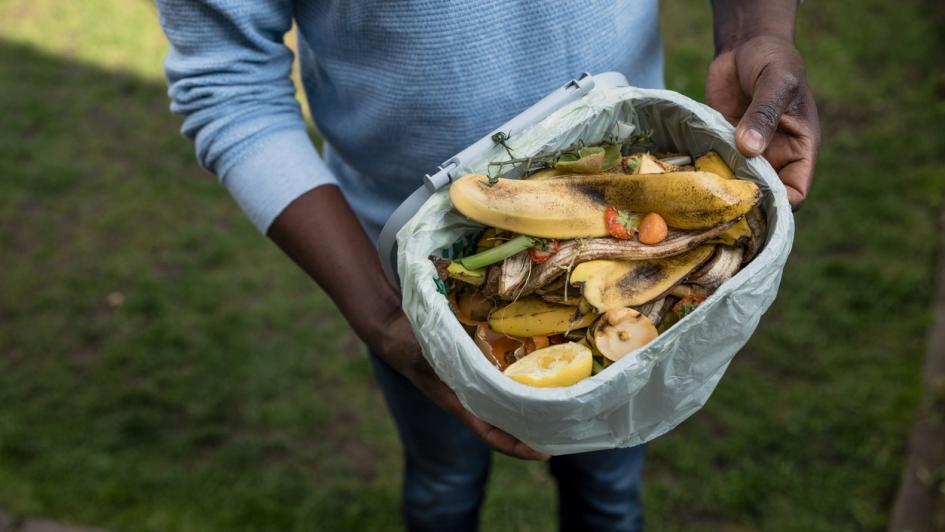Your Guide to Apartment Composting

Published
If composting conjures images of sprawling gardens and ample outdoor space, it's time to reset that notion. Contrary to popular belief, you don't need a yard to embark on the transformative journey of composting. Whether you're settling into a dorm room or bustling city apartment, you too can become a composting pro in even the coziest of spaces.
Did you know that the United States produced 292.4 million tons of solid waste in 2018 alone? This is about 4.9 pounds of waste per day for every American! In addition, the average person living in the United States throws away 1,200 pounds of organic materials that could be composted each year.
WHAT EXACTLY IS COMPOSTING?
Composting is breaking down waste, such as food scraps and yard waste, into organic material that can be used to enrich the soil. There are four components or ingredients of compost. They are:
-
Brown material, such as dead leaves, branches, and twigs
-
Green material, including grass clippings, vegetable waste, fruit peels, and coffee grounds
-
Water
-
Air
Together, in balanced amounts, these create the perfect recipe for making nutritious material called “compost” to add to the soil for plants.
WHY SHOULD YOU COMPOST?
Composting is vital to helping reduce the amount of waste produced each year. Besides the big benefit of reducing the amount of material that ends up in landfills, there are five other major benefits of composting. They are:
-
Enriches and nourishes the soil
-
Eliminates the need for chemical fertilizers
-
Encourages the creation of humus (rich nutrient-filled) material through the production of bacteria and fungi that break down organic matter
-
Decreases methane emissions from landfills
-
Lowers your carbon footprint
So, composting doesn’t only benefit you, but it also makes an impact on the environment. Composting is just one small step we, as individuals, can make to protect the earth.
A word of caution: Some types of composting can attract rodents and other creatures. While this is highly unlikely in an apartment, it can happen in a residential home. However, there are many ways to prevent this from happening.
HOW DO YOU COMPOST IN AN APARTMENT?
You might be wondering, “Where do you begin with composting in an apartment?” You might not have a yard at all, you might not have a balcony, and you might not have space in your actual apartment. But you can still compost! There are many options for composting, and here are some listed below. Determine which one works best for you and your needs in your apartment. Don’t let living in an apartment be a barrier to composting.
Option 1: Worm Bin
This is a fairly cheap option depending on whether you create your own worm bin or you purchase one. In simple terms, a worm bin is a bin with worms and dirt, and then you add your food waste to this bin. You essentially have pet worms (if you want to think of it like that). You can feed the worms almost any fruit or vegetable waste, but you should not feed them fat, bones, dairy, or meat. In addition, the worms might have difficulty with stems, a lot of citrus products, and outer layers of onions. When you feed your worms, dig a hole and bury it beneath the soil. It is important that you also add some paper because this balances out the carbon and nitrogen ratio. If your compost starts to smell, then you know something is out of balance. It is crucial that you don’t feed the worms too much at once because this could cause infestation of insects in your bin. For a more detailed description of how to create a worm bin, check out the EPA’s article called “How to Create and Maintain an Indoor Worm Composting Bin.”
Option 2: Electric Composting
Another great option for composting in an apartment is an electric composter or a food recycler. This process involves three phases - drying, grinding, and cooling. Collectively, it can take anywhere from 5 hours or up to 48 hours for the production of compost. During the drying process, weed seeds, plant diseases, and pathogens are killed while the volume of the compost is decreased. Then, the grinding phase further breaks down the waste into small particles resulting in a product that can be mixed with soil. Lastly, the cooling phase brings the final product to a safe temperature for immediate use. Unlike regular compost, the final product is dry and does not contain any bacteria, so it cannot be used as a topsoil. However, it can be mixed with other soil. This type of composting can be expensive and models vary in size, so it is best to do some research and find an option that fits your needs. Examples of common electric composter models are Vitamix FoodCycler FC-30, Smart Cara CS-25 W, and Compostio C30.
Option 3: Community Garden
If you do not want to create your own compost because you will not be able to use it, then you can research to see if a local community garden has a composting site. In this case, you could collect your compost in a bin, and when you have time, you could take it to the community garden. This option might only be available during the growing season. However, you can feel free to reach out to a community garden near you to see if they offer this. It’s a win-win situation because you are getting rid of your compost, and the community garden is receiving material that makes the soil better! Also, if you have your own plot already, use your compost to nourish your garden.
Option 4: Farmers Market
Depending on where you live, some farmer's markets or some farmers might be interested in taking your compost. Simply reach out to a local farmers market or farmer to see if this is a possible option. You could arrange a time for a weekly or bi-weekly drop-off.
Are you worried about the smell? If you are worried about the smell of your compost, then simply put it in the freezer until you drop it off at the location. There are also great options for compostable bags and bins that eliminate or reduce odor.
Option 5: Local Yard Site
Another option for your compost is to find a local yard site that accepts compost. Depending on the location, you may or may not have to pay for dumping your compost. This is a good alternative if none of the other options above work.
Option 6: City Wide Service
Along with your garbage and recycling weekly pick up, many companies offer compost picked up weekly (at an additional charge). However, it might be challenging living in an apartment complex. If not already available, reach out to your community manager to see if they could add this service. Most of the garbage and recycling services also have a composting service. This is a wonderful way to be an environmental advocate in your community. Maybe, you could even get a petition going for this service to be provided at your apartment. Plus, this is a great option if you are worried about creatures being attracted to your compost.
If you are living in an apartment, don’t be discouraged because there are many options that allow you to compost! Seek the option that works best for you and start making an impact on the environment. Let’s feel good about reducing waste and creating compost to make a positive impact on the environment.
Hannah is a dietetic intern at Bastyr University.
References
-
National Overview: Facts and Figures on Materials, Wastes and Recycling. US EPA. https://www.epa.gov/facts-and-figures-about-materials-waste-and-recycling/national-overview-facts-and-figures-materials#:~:text=The%20total%20generation%20of%20municipal,25%20million%20tons%20were%20composted. Published 2020. Accessed January 9, 2021.
-
Solid Waste & Landfill Facts - University of Southern Indiana. University of Southern Indiana. https://www.usi.edu/recycle/solid-waste-landfill-facts/#:~:text=Every%20year%2C%20each%20American%20throws,40%25%20of%20the%20world's%20waste. Accessed January 9, 2021.
-
Composting At Home. US EPA. https://www.epa.gov/recycle/composting-home. Accessed January 9, 2021.
-
How to Create and Maintain an Indoor Worm Composting Bin. US EPA. https://www.epa.gov/recycle/how-create-and-maintain-indoor-worm-composting-bin#:~:text=Combine%20shredded%20paper%2C%20soil%20and,not%20forming%20puddles%20of%20water. Accessed January 9, 2021.
-
Cowan S. How to Compost in an Apartment. Eartheasy. https://learn.eartheasy.com/articles/how-to-compost-in-an-apartment/. Published 2019. Accessed January 9, 2021.
-
Miller S. Electric Composters: What Are They and How Do They Work?. Foodcycler.com. https://www.foodcycler.com/post/electric-composters-what-are-they-and-how-do-they-work. Published 2019. Accessed January 9, 2021.


